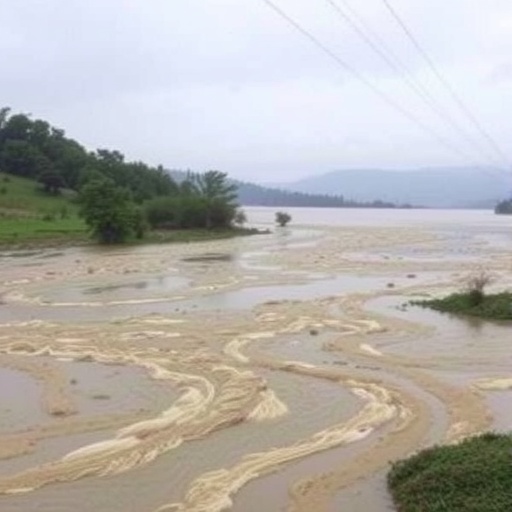Flooding is often seen as a natural calamity, but the aftermath can lead to significant environmental consequences that pose severe risks to public health. A recent study conducted in the mid-Brahmaputra Valley in India reveals how flood-induced contamination can result in heavy metal pollution, affecting the lives of countless residents dependent on the river for their livelihoods. As extreme weather events become more frequent due to climate change, understanding the implications of heavy metal contamination is more vital than ever.
The mid-Brahmaputra Valley has long been known for its rich biodiversity and extensive water resources, serving as an economic lifeline for the communities residing along its banks. However, when floods occur, the usual flow of the river is disrupted, leading to the inundation of local lands where industries, agricultural fields, and even dump sites are located. This flooding can mobilize heavy metals that have been historically accumulated in the soil and water, transforming these usually safe areas into toxic zones.
To comprehend the extent of this issue, researchers D. Kalita and A.K. Das conducted an in-depth analysis to assess the levels of heavy metals ubiquitous in this riverine settlement. Their findings suggest that metals like lead, arsenic, and cadmium were present in concentrations far exceeding safe limits. These metals are known for their deleterious effects on human health, leading to long-term illnesses that can severely impact the quality of life for affected individuals.
The study involved rigorous sampling and testing protocols, including sediment and water samples collected from various points along the river. Each sample was analyzed with advanced techniques to quantify the concentrations of these harmful metals. This attention to detail ensured that the researchers compiled accurate data, providing a clearer picture of the pollution levels faced by communities adjacent to the river.
One of the most concerning findings from the study was the link between heavy metal exposure and negative health outcomes in local populations. Increased incidences of conditions ranging from respiratory issues and skin diseases to neurological disorders were reported, with vulnerable populations such as children and the elderly being especially at risk. The researchers emphasized that the local government and health officials must take these health threats seriously, as continued exposure could lead to chronic conditions, undermining public health.
Furthermore, the study highlighted the socio-economic implications of heavy metal contamination. As local residents grapple with health issues, they face reduced productivity and increased healthcare costs. Many community members rely on agriculture and fishing for their livelihoods, both of which are directly compromised when water sources become polluted. As a result, the study serves as a wake-up call, urging comprehensive strategies to combat the occurrence of flooding and the subsequent leakage of hazardous materials.
Among the recommendations put forth by the researchers, the implementation of improved waste management practices stood out as crucial. Ensuring that industrial waste is adequately managed and disposed of can significantly reduce the heavy metal burden in the environment. In addition, community education programs aimed at raising awareness about the risks of heavy metal exposure can empower residents to advocate for their health and environment.
Preventative measures also need to be prioritized to mitigate the risks posed by flooding. Infrastructure improvements, such as better drainage systems, can help manage excess water during heavy rainfall, thereby reducing the chance of toxic material being washed into populated areas. The combined effort of governmental authorities, local communities, and environmental agencies is vital in crafting plans that not only address immediate concerns but also establish a resilient framework for the future.
Moreover, this study underscores the necessity for ongoing research and monitoring of water quality in the mid-Brahmaputra Valley and similar regions prone to flooding. Continuous data collection will help track the levels of contamination and support the formulation of evidence-based policies. Stakeholders can utilize this information to inform interventions targeted at reducing health risks and restoring water safety.
As climate change exacerbates the frequency and intensity of natural disasters, studies like this are increasingly essential. They shed light on previously overlooked issues of environmental health and provide a crucial foundation for public health initiatives and policy changes. Ensuring that communities are not only resilient in the face of flooding but also safeguarded against the long-term effects of contamination must become priority agendas for policymakers.
In conclusion, the research conducted by Kalita and Das brings to the forefront an urgent issue that transcends geographical bounds. The heavy metal contamination in the mid-Brahmaputra Valley highlights the hidden crises that can arise from seemingly natural events. As the world grapples with climate change, the interconnectedness of environmental health, community well-being, and economic stability must be a central focus. Tackling these challenges will require concerted efforts, innovative solutions, and a commitment to protecting both people and the ecosystems they depend on for survival.
By shedding light on the often invisible consequences of flooding, we can begin to navigate toward a more sustainable and health-conscious future, ensuring that rivers like the Brahmaputra continue to be lifelines rather than sources of contamination and disease.
Subject of Research: Flood-induced heavy metal contamination and associated human health risk assessment over a riverine settlement in mid-Brahmaputra Valley, India.
Article Title: Flood-induced heavy metal contamination and associated human health risk assessment over a riverine settlement in mid-Brahmaputra Valley, India.
Article References:
Kalita, D., Das, A.K. Flood-induced heavy metal contamination and associated human health risk assessment over a riverine settlement in mid-Brahmaputra Valley, India.
Environ Monit Assess 197, 1033 (2025). https://doi.org/10.1007/s10661-025-14446-z
Image Credits: AI Generated
DOI: 10.1007/s10661-025-14446-z
Keywords: Flooding, heavy metals, contamination, public health, mid-Brahmaputra Valley, environmental health, climate change.




